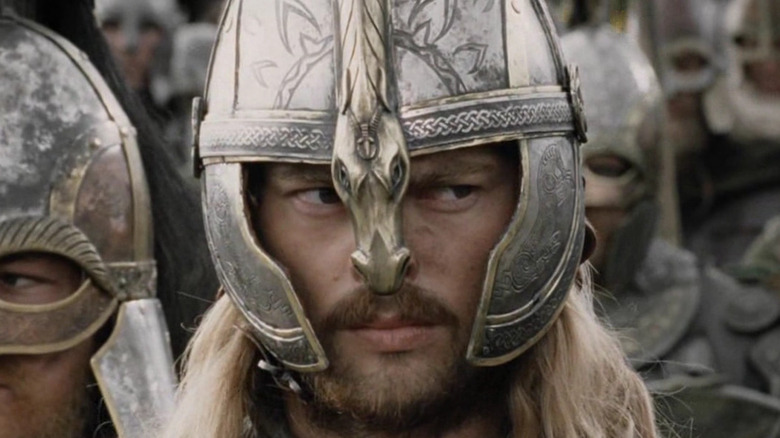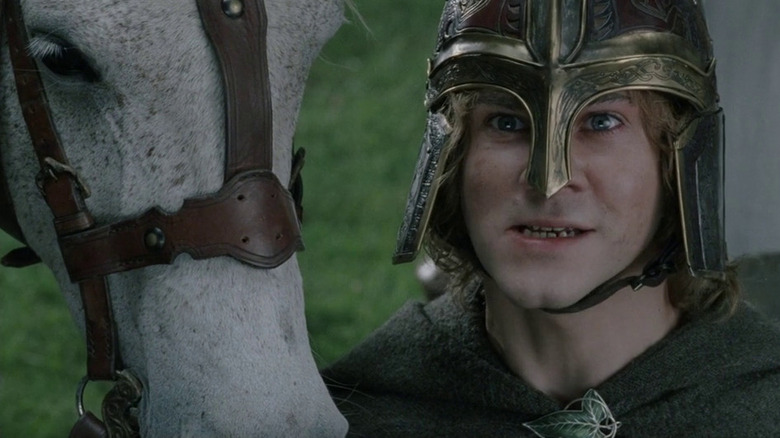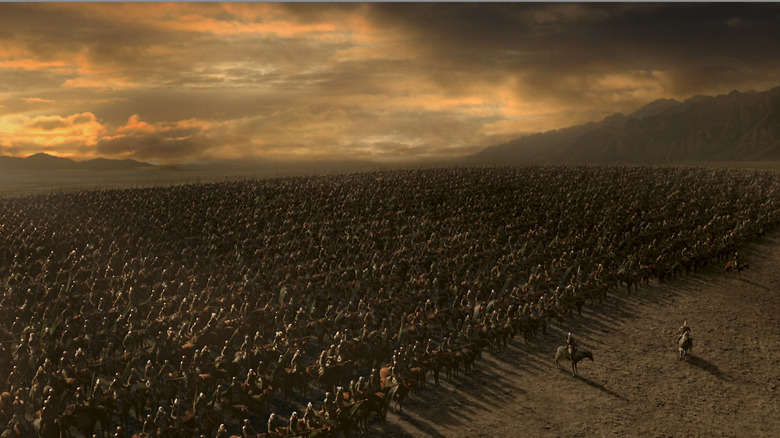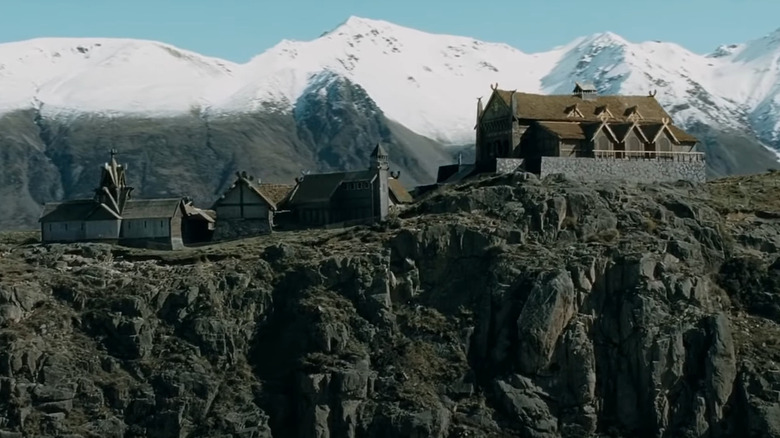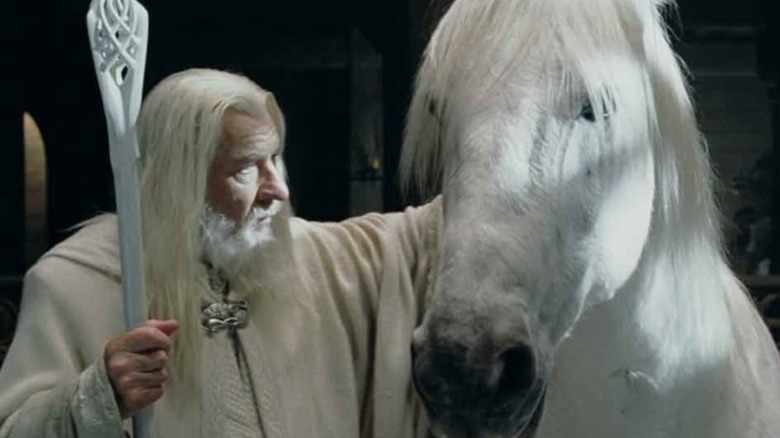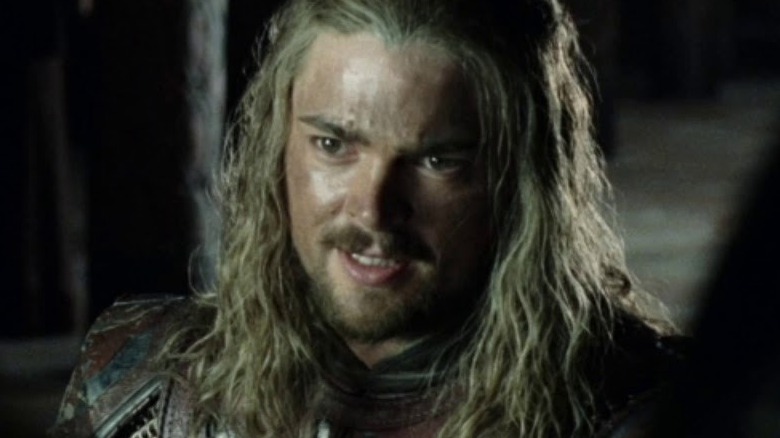The Lord Of The Rings: The Rohirrim's Backstory Explained
There are few characters in J.R.R. Tolkien's vast mythology as beloved as the Rohirrim. The scrappy-yet-majestic horse-lords live simple lives, are loyal to their friends and are recklessly fierce warriors that you always want to have in your corner. The Rohirrim play a critical part in "The Lord of the Rings" saga. They kick things off by fending off Saruman's hordes of Uruk-hai throughout "The Two Towers." Next, they pack up shop and head down to Minas Tirith for the over-the-top epic Battle of the Pelennor Fields in "The Return of the King." From there, they head right on to the Black Gate, where they dodge death by a hair's breadth and witness the downfall of Sauron in person.
There's no doubt that the men and women of Rohan play an integral part in the primary narrative of the Trilogy. But we don't really get much information about who they themselves are. Who is this mysterious group of plain dwellers who call themselves the Eorlingas? How did they come to live in the land that they personally refer to as the Riddermark — or "the Mark" for short?
With Warner Animation and New Line Cinema feverishly working on a Middle-earth anime titled "The War of the Rohirrim," we decided to take a deeper dive into the history of the horse-lords to help prepare for the upcoming festivities. And it turns out that there's actually quite a bit to unpack.
There's the obvious stuff, such as the fact that they like horses ... like, a lot. But, of course, connecting the Rohirrim to horses is like saying superheroes like capes. It may be true, but it also isn't news for most people. Fortunately, there's a lot more to the Rohirrim than their steeds. Here's a breakdown of the people of Rohan and their (relatively) short stint in Middle-earth's long history.
The Rohirrim cross over with a lot of other peoples
The Riders of Rohan don't come into the Middle-earth story until five centuries before "The Lord of the Rings" begins. This may sound like a lot, but in all reality, it's just a sliver of the tens of thousands of years that Tolkien wrote into the backstory of his world. That said, when they do ride into the picture, the Men of Rohan don't appear out of thin air. They come with their own misty chronicles and legends. While there isn't much to work with, there are a few juicy nuggets of information that help puzzle together just what the Rohirrim were up to before they arrived in their future homeland.
For one thing, Tolkien hints that they may have been distantly related to the Three Houses of Men that helped the Elves in the First Age of Middle-earth, via Tolkien Gateway. In "The Two Towers," Faramir even refers to the horse-lords as "our kin from afar off." This bond helps promote the connection between Gondor and Rohan.
In the appendix of "The Return of the King," it also explains that they "were in origin close akin to the Beornings" — this tracks since they live in his neck of the woods before they move to Rohan (more on that in a bit). While not necessarily related, the Rohirrim also appear to have had some cultural similarities with the Men of Dale (think: Bard the Bowman from "The Hobbit") as they share names and words in their respective languages.
To top it off, the Rohirrim have had run-ins with Hobbits early in their history. Before the Little People migrated to the Shire, they lived in the same region as the horse-lords. In fact, Théoden even references this the first time he meets Merry and Pippin in "The Two Towers," remarking on old legends that his people still maintained about the Holbytlan or Halflings who "dwell in holes in sand-dunes."
The founding of Rohan
Before they live in Rohan, the Rohirrim (who are called Northmen at this point) live in the northeastern portion of Middle-earth. This is an area where Hobbits once lived, where Beorn dwells during "The Hobbit," and where the One Ring is eventually found by Gollum in the muck at the bottom of the Great River. During these early years, these Northmen gain a reputation for fierceness. One of their princes, a rough-and-tumble dude named Fram, actually kills a dragon named Scatha. When the local Dwarves demand some of the worm's horde of treasure, Fram sends them a necklace of the monster's teeth instead, after which the Dwarves kill him for the insult. This sets up some not-so-nice relations between the two peoples going forward.
Five hundred years before the War of the Ring, the Northmen get a call from the Men of Gondor, who find themselves outnumbered by a two-pronged attack of Men and Orcs. Just when all seems lost, the Northmen, led by their most famous king, Eorl, arrive out of the north and help the Gondorians win the Battle of the Field of Celebrant, according to Tolkien Gateway.
After this timely helping hand, Gondor decides to surrender the entire northern region of its kingdom to their new best buds. In Tolkien's posthumously published book "Unfinished Tales," the Steward of Gondor at the time, a fella named Cirion, gives the land to the Rohirrim. He tells King Eorl that they shall have complete autonomy and be governed by their own laws with the one exception that "they shall live in perpetual friendship with Gondor and its enemies shall be their enemies while both realms endure." The Steward also adds that "the same bond shall be laid also on the people of Gondor." This sets up the "you help me, I'll help you" dynamic that is such a constant refrain throughout "The Lord of the Rings."
A way-too-fast history of Rohan
Once they've been gifted their new homeland, the Rohirrim settle in. They don't build many larger, foot-bound cities or urban centers. Instead, they mostly dwell on the plains in villages that accommodate their equine lifestyle.
From its founding to the War of the Ring, the land is ruled by the Kings of Rohan (via Tolkien Gateway), a group exclusively descended from their original leader Eorl. Together, they guide their nation through the dramatic fortunes of Middle-earth. Early on, the Rohirrim also build their famous Golden Hall — the same hall that Théoden is sitting in when Gandalf and friends arrive in "The Two Towers." Along with their own hall, the horse-lords also continue to care for several Gondorian structures that they inherited. The most famous of these is the fortress of Aglarond.
About halfway into Rohan's history, the land is overrun by an invasion, and its king, another badass dude named Helm Hammerhand, is forced to retreat to this stronghold with his surviving soldiers. The following siege goes down as one of the most melodramatic moments in all of Rohirric history. In fact, it's such a barn burner that it's the central plot of Warner Animation and New Line's film. Following the historic siege, the area becomes known by the familiar title of Helm's Deep. Sound familiar? Yeah, we thought so.
Apart from that major event, the bulk of Rohan's history basically follows in lockstep with Gondor. The two nations remain side by side, shielding the rest of the West from the horrors of Sauron and the other forces of darkness that lurk along their borders. Saruman moves into Isengard around the time that Helm is king, but for a long time, he's seen as an ally. It isn't until the War of the Ring that push comes to shove, and the Rohirrim are finally forced to fight for themselves, their Gondorian brothers, and all the Free Folks of Middle-earth.
The Rohirrim and their horses
There are few things that define the people of Rohan so much as their horses. The horses of the Rohirrim are so integral to their culture, that they're literally in their name. In "Unfinished Tales," Tolkien explains — in many densely verbose paragraphs — that the word Rohan is a Sindarin word (a form of Elvish) that translates as "horse land," "horse country," or something along those lines. Similarly, Rohirrim roughly means "host of horse lords."
Of course, the Rohirrims' obsession with horses goes beyond words. In "The Return of the King," it says that, "they loved best the plains, and delighted in horses and in all feats of horsemanship." In "The Two Towers," Éomer is seriously offended when he hears a rumor that Rohan pays a tribute of horses to Mordor. Needless to say, these guys love their four-legged friends. From their lifestyle to their living spaces, they're always ready to accommodate their equine affinity in all that they do.
The first famous horse of Rohan is called Felaróf. He's Eorl's horse, and the proud inaugural king of the Rohirrim doesn't come by his horse easily. We once again turn to the appendix of "The Return of the King" where it explains that Eorl's father was thrown and killed when trying to tame the wild beast. Only 16 years old at the time, Eorl hunts down his father's killer and tames the beast by sheer willpower. He rides him without a bit or bridle, and the horse becomes the first of a line of powerful elite horses called the Mearas, per Tolkien Gateway.
These exceptional beasts could understand "all that men said" and "would bear no one but the King of the mark or his sons." This remains the status quo until Shadowfax, the chief of the Mearas, breaks protocol by allowing Gandalf to ride him.
Rohan after the War of the Ring
Rohan rebuilds its strength and continues to flourish after the War of the Ring ends. However, at this point, there's one little technicality that needs to be tended to. When the Steward Cirion gives the land to the Rohirrim, he's technically doing so in the name of the king. In "Unfinished Tales," where he makes the proclamation, he backs up his gift with the words "while the authority of the Stewards endures, until the Great King returns."
Well, in "The Return of the King," that king makes his comeback in the form of Aragorn, son of Arathorn. Once the ranger is reinstated to the throne, it legally ends the original agreement, even if the phrase was originally included as more of a formality. This kind of leaves Rohan's status up in the air for a second — but only for a second. As fans of "The Lord of the Rings" know, Aragorn owes a lot to Rohan for the saving of his kingdom, and he doesn't hesitate to show his gratitude. In "The Return of the King," he tells Éomer that "between us, there can be no word of giving or taking, nor of reward; for we are brethren."
In the appendix that follows, it also clarifies that "In all the lands of those realms of old [Aragorn] was king, save in Rohan only; for he renewed to Éomer the gift of Cirion, and Éomer took again the Oath of Eorl." It adds that the two kings rode to war together often, and all over the Middle-earth map, too. We hear little tidbits of additional information here and there, like the fact that Merry and Pippin visit Rohan in their old age (via Tolkien Gateway). On the whole, though, the story of Rohan after the War of the Ring seems to be a simple one spent basking in the relative peace that the people of the plains enjoy so much.
